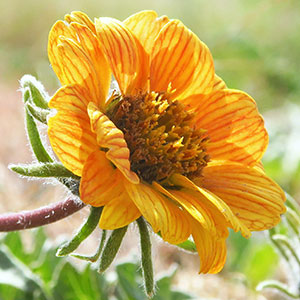Balsamorhiza rosea
Balsamorhiza macrolepis
rosy balsamroot
big scale balsam root, California balsamroot
blades gray-green, oblong to lance-ovate, 3–10(–20) × 2–5 cm (rarely pinnately lobed), bases weakly cordate or truncate, margins crenate to serrate, apices rounded to acute, faces finely strigose to moderately scabrous (usually gland-dotted as well).
blades green to gray-green, elliptic to lanceolate, 15–40+ × 4–14 cm (1–2-pinnatifid, primary lobes ovate to linear, 15–70 × 3–15 mm, usually lobed or toothed), bases cuneate to truncate, ultimate margins usually entire (slightly revolute, not ciliate), apices rounded to acute, faces strigillose to subvelutinous or tomentose (sometimes gland-dotted as well).
hemispheric, 18–20 mm diam.
hemispheric, (15–)20–30 mm diam.
(becoming brick-red, often drying to pink or rose, and chartaceous) (8–)15(–25) mm (hispidulous abaxially; cypselae strigose).
20–30+ mm.
deltate or ovate to lanceolate, 8–12 mm, not surpassing inner.
ovate or oblong to lanceolate, 12–30(–40) mm, usually surpassing inner, apices obtuse to acute or attenuate.
usually borne singly.
usually borne singly.
= 38.
Balsamorhiza rosea
Balsamorhiza macrolepis
In a hybrid swarm involving Balsamorhiza rosea and B. careyana, B. rosea remains relatively uncontaminated; the dominance among the hybrids appears to lie with B. careyana. A record of a hybrid between B. rosea and B. careyana from the Spokane area is doubtful.
(Discussion copyrighted by Flora of North America; reprinted with permission.)
Of conservation concern.
Balsamorhiza macrolepis grows in the western foothills of central Sierra Nevada and in the eastern San Francisco Bay area (there mostly extirpated). The tall habit, exhibiting gigas characteristics, suggests that, like B. macrophylla, this taxon may be a polyploid. No hybrids with other species have been noted.
(Discussion copyrighted by Flora of North America; reprinted with permission.)


